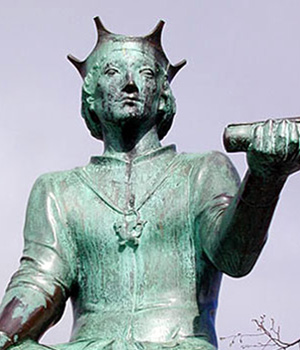| Købstædernes expansion

| | Under unionsregenterne Magrethe den 1. og Erik af Pommern påbegyndes en systematisk politik til ophjælpning af byerne og handelen.
Erik af Pommern fremmer købstadslovgivningen, giver købstadsrettigheder til en række byer i Øresundsregionen, grundlægger Landskrona i 1413, og indfører Øresundstolden i 1429. |
Kalmarunionen og købstædernes vækst
I slutningen af 1300-tallet er Skånemarkedets betydning vigende og handelen flytter bort fra Skanør og Falsterbo til bl.a. Malmø og København, der nu kunne byde på et større opland og mere købedygtigt publikum. Hen imod slutningen af århundredet manifesterer Norden under Kalmarunionen (1397) med Margrethe d.1. i spidsen modstand imod hansestædernes økonomiske dominans og under Margrethes arving Erik af Pommern (1412-39) påbegyndes en systematisk politik til ophjælpning af byerne og handelen.

Kalmarunionen | 
Erik af Pommerens kroning |
Kongens initiativer
Erik af Pommern var fuldt ud klar over købstædernes og i særdeleshed Øresundsregionens betydning som det vigtigste gennemfartsfarvand imellem Østersøen og Nordsøen, hvilket fremgår af en række samtidige tiltag. Landskrona grundlægges i 1413, 1414 får Helsingborg købstadsrettigheder, i 1416 erhverver kongen København fra Roskildebispen og fra omkring 1419 befæstes Malmø med svære stenmure.
Med opløsningen af Skånemarkedet begynder hanseaterne at handle direkte med byerne og landbefolkningen, men fra 1422 forordnes det på Sjælland at hanseaterne kun må drive engroshandel, mens detaillehandel og håndværk skal overlades til byernes faste borgere. Adelen er dog undtaget fra disse regler.
Helsingørs købstadsrettigheder 1426
Helsingør har i tidlig middelalder formodentlig kun bestået af et mindre voldsted omkring Flynderborg med tilhørende overfartsmuligheder og måske fiskeri på forstranden. Kongemagten, i dette tilfælde Erik af Pommern, anlægger i begyndelse af 1400-tallet borgen Krogen og tilskynder til at flytte byen ud i nærheden af borgen.
Helsingør får købstadsrettigheder i 1426 i sammenhæng med opførelsen af Krogen og kulminationen på denne proces bliver indførelsen af Øresundstolden i 1429, som en slags erstatning for de tabte indtægterne fra Skånemarkedet. Henlæggelsen af opkrævningen til det smalle stræde imellem Helsingør og Helsingborg er logisk set i sammenhæng med ændringerne i skibstrafikken og handelsvejene.

Helsingør |
Helsingborg og Malmø
Helsingborg får købstadsrettigheder i 1414. Særlige bestemmelser heri omhandler salg af sild om efteråret og færgeoverfarten imellem Helsingborg og Sjælland. Helsingborg var med sin gode beliggenhed og stærke befæstning, der var et led i den tidlige middelalders række af kongelige forsvarsanlæg langs kysterne, oprindelig meget større end Helsingør, men med tiden bliver Helsingør på grund af tilknytningen til Øresundstolden og fjernhandelen, rigets tredjestørste by, næst efter København og Malmø. Malmø er en forholdsvis ny by og dens oprindelige navn Elbogen vidner om den hanseatiske indflydelse i området.

Helsingborg | 
Landskrona | 
Malmø | 
Helsingborg model 1400 |
Konkurrence mellem byerne
Stadig flere købstæder betyder også en stigende indbyrdes konkurrence. Omkring år 1500 må kong Hans(1481-1513) således mægle imellem en række byer. Efter en bestemmelse fra marts måned 1506 må borgerne i Lund og Væ på den ene side og Malmø på den anden ikke handle på hinandens torve og borgerne i Lund og Væ må kun handle med udenlandske købmand i Malmø på høstmarkedet.
Man fornemmer her kystbyernes stigende betydning, men disse har også indbyrdes kontroverser, som når det i september måned samme år bestemmes at borgerne i Lund, Helsingborg og Landskrona ikke må handle hos hinanden og at Lund og Helsingborg ikke må handle med udenlandske købmænd i Landskrona. Landskronas grundlæggelse sigtede på handel med Holland og England.
Helsingør-Helsingborg
Forholdet imellem Helsingør og Helsingborg er helt specielt idet de to byer fra 1541 får fælles torv, hvilket betyder at folk fra Helsingborg kunne sælge varer direkte på torvet i Helsingør. F.eks. havde 10 slagtere fra Helsingborg på et tidspunkt boder i Helsingør og fra Helsingør kom man ofte to gange om ugen over til Helsingborg for at handle kød og forarbejdede mejerivarer.
Forklaringen her er formodentlig, at tilgangen til animalske produkter var bedre i Skåne end i Nordsjælland. Helsingør må også fortsat importere korn langvejs fra og er i det hele taget atypisk med sit manglende opland og den specielle tilknytning til fjernhandelen.
Handel og konflikter
Udenlandske købmænd spiller fortsat en afgørende rolle i regionen. Rivalisering og kontroverser med hansestæderne fortsætter op igennem 1400 og starten af 1500-tallet med skiftende held og stigende konkurrence fra nederlænderne, der primært handlede med salt og klæde på Danzig og Riga. Et udtryk for ændringer i styrkeforholdet er det at hollænderne i 1490 under kong Hans opnår samme privilegier som hanseaterne.
Christian 2.(1513-23) fortsætter og udbygger Erik af Pommerns by- og handelspolitik ved at skærpe bestemmelserne omkring handelsret og forbyde handel udenom byområderne. Christian 2. bliver ligesom Erik af Pommern sat fra tronen, men især Malmøs borgere forblev hans trofaste støtter og han huskes for sit tætte forhold til både Malmø og Helsingør. Konger forgår, men visioner består, og den om Øresund som centrum og forbindelsesled imellem Nordsø og Østersø lever videre også i tiden fremover. |